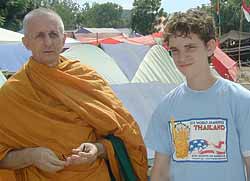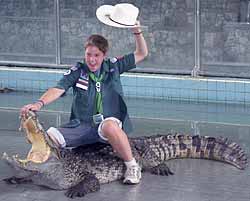![]() May - June 2003
May - June 2003
The 20th World Jamboree
'Share Our World, Share Our Cultures'
By Kim Brady,
Assistant Scoutmaster, Troop 431, Roswell, Ga.
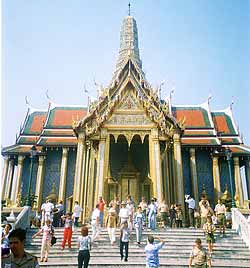 In Bangkok, Scouts were able to visit magnificent architectural landmarks, like those in the compound of Wat Phra Kaeo, the Temple of the Emerald Buddha. |
The 20th World Scout Jamboree took place in Thailand from Dec. 28, 2002, to Jan. 7, 2003. More than 24,000 Scouts and leaders, from nearly every Scouting association in the world, assembled for a festival of friendship and fun. Their campground was a 3,000-acre coastal site on the Gulf of Thailand, a three-hour drive from the capital city of Bangkok.
The jamboree featured a variety of activities and events related to the theme "Share Our World, Share Our Cultures." Eight program modules, with themes like Crossroads of Culture, City of Science, Face the Waves (aquatics), and Exploring Nature, offered a full or half day of individual or patrol activities, workshops, and competitions. Exciting opening and closing ceremonies highlighted the jamboree's tone of friendship and universal Scouting spirit.
A contingent of 855 Scouts, Venturers, unit leaders, and service staff members represented the Boy Scouts of America at the jamboree. Three of the BSA representatives share their special jamboree memories on these pages.
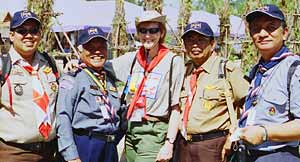 During a break from her newspaper duties, Kim Brady shares a Scouting moment with leaders from Indonesia and Malaysia. Photograph Courtesy of Kim Brady/WOSM |
Writer/photographer Kimberly Brady, an assistant Scoutmaster with Troop 431 in Roswell, Ga., served on the staff of Sawasdeejam, the jamboree daily newspaper. Her son, Jonathan, a Scout in Troop 431, was a member of the BSA Southern Region's jamboree Troop 23. Jamie Ernst of Venturing Crew 425, Irving, Tex., was one of 105 Venturers in the BSA contingent.
A Life-Changing Experience
Months of planning and preparation were about to culminate in the Scouting adventure of a lifetime, living as a "family" with nearly 24,000 Scouts and leaders from more than 140 countries.
My 16-year-old son, Jon, and I had been looking forward to the 20th World Scout Jamboree for nearly four years. I was drawn to the exotic setting, and it would be Jonathan's first time overseas.
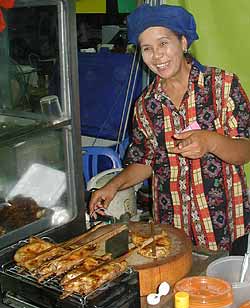 Vendors offered a variety of Thai foods, cooked to order in an outdoor market. Photograph By Kim Brady/World Organization Of The Scout Movement |
Neither of us realized just how life-changing the experience would be.
We traveled to Thailand on different planes because Jonathan was a member of Troop 23 in the BSA Southern Region contingent and I was a photographer for the jamboree newspaper. As my flight of 24 hours ended at Bangkok's International Airport, I knew my adventure had begun.
'The Land of Smiles'
The hospitality of the Thai people and the planning of the World Organization of the Scout Movement (WOSM) were evident as we were escorted to the Scout Welcome Area.
There I met my first group of new friends—fellow staff members from the United States, Netherlands, and Switzerland. We talked, swapped patches, and napped while waiting for a bus to the jamboree, a three-hour drive from Bangkok.
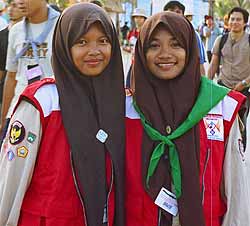 Uniforms like those worn by these Girl Guides from Indonesia added to the jamboree's Scouting kaleidoscope. Photograph By Kim Brady/World Organization Of The Scout Movement |
The site, a flat plain on the coast, was provided by the Thailand navy. The size of a small city, it was divided into dozens of subcamps, villages, and activity centers.
Numerous roads crisscrossed the camp, with a main street down the center serving as the major thoroughfare for pedestrians, buses, bicycles, and delivery vehicles.
It didn't take long to realize why Thailand is called "The Land of Smiles." Every Thai person I met smiled and bowed as he or she passed by, often stopping to ask where I was from and to have a picture taken with me. Their outgoing manner and charming personalities were contagious and made the jamboree especially enjoyable.
Adapting to jamboree life
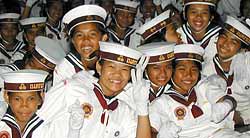 On opening night, Sea Scouts show why Thailand is called "The Land of Smiles." Photograph By Kim Brady/World Organization Of The Scout Movement |
The weather was hot and muggy, and I was thankful for the BSA contingent's wide-brimmed safari hats and my wrap-around sunglasses. I was also thankful that bottled water was available from vendors along most roads.
I rented a bright yellow bicycle to make the mile-and-a-half trek from my subcamp to the newspaper office. (I mastered riding it after only three days, a few dozen bruises, and some half-dozen crashes.)
Two staff cafeterias featured scrambled eggs and sausage or cereal for breakfast. A salad bar and rotation of McDonald's sandwiches and Kentucky Fried Chicken pasta bowls were available for lunch and dinner. Troops cooked breakfast and dinner in their campsites, after first collecting the food at one of three supply sites. Thai Airlines provided boxed lunches for midday meals and field trips.
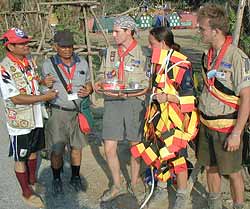 Scouts from Belgium and Thailand greet each other on International Day. Photograph By Kim Brady/World Organization Of The Scout Movement |
Staff and Scouts also got to try some traditional Thai foods. An outdoor market sold authentic Thai meals, cooked while we waited, for about 35 baht (less than $1). The menu ranged from squid to barbecued chicken to (my favorite) egg omelets and rice. The most popular desserts were sliced pineapple and split coconuts, with straws to drink the liquid and spoons to scoop out the fresh meat.
International kaleidoscope
On Dec. 27, busloads of Scouts began arriving, dressed in their national Scout uniforms, creating an international kaleidoscope.
I was impressed by how Scouts from different regions and cultures adapted the uniform. Girls from some Muslim Scout associations, for example, were completely covered, including a headdress, with tunics or sashes to display their badges. Male Scottish Scouters sported classic kilts, while the Thai Scouts wore formal military-like uniforms, with pressed shirts and shorts, berets, and long skirts for women and girls.
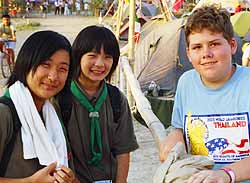 Daniel Jakel, of Montgomery, Ala., chats with two Japanese Scouts at his campsite. Photograph By Kim Brady/World Organization Of The Scout Movement |
The Scouts usually dressed in more informal uniforms at the numerous program and activity centers, like the Global Development Village, the jamboree's international awareness program, where workshops in health, environment, peace, and human rights were co-sponsored by UNICEF and other worldwide organizations.
Among the most popular programs was the City of Science, where Scouts learned about robotics, communications, life sciences, agriculture, and the universe. The Crossroads of Culture was my favorite area to photograph, because of the traditional settings, clothing, and arts. Visitors learned about living and Scouting in other parts of the world. Scouts could have their pictures taken in traditional clothing, play local musical instruments, or learn crafts such as origami, oriental painting, bamboo art, and hand lettering.
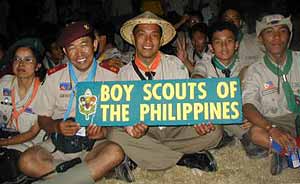 Two Thai Scouters, at left, join with Philippine Scouts in the festive closing ceremonies. Photograph By Kim Brady/World Organization Of The Scout Movement |
Prayer Valley was another area that helped illustrate Scout ideals by educating visitors in the great diversity of religious practices around the world.
With all that was going on around the jamboree, and field trips to the zoo, crocodile farm, and the village where the Scouts conducted their one-day service projects, there was no time for boredom. The challenge was to experience as much as possible, so we could share what we learned with our councils and troops at home.
Photographer's dream
You could hear hundreds of dialects throughout the camp. Despite this, everyone seemed to communicate well, even if with just a smile and a bow. The entire camp seemed connected by the spirit of Scouting, with its symbols, ideals, promise, and laws.
 Scouts from Indonesia wear sashes on which they proudly display the many badges they've earned. Photograph By Kim Brady/World Organization Of The Scout Movement |
The jamboree was a photographer's dream, and I grabbed every opportunity to photograph the young men and women I met in camp. Their smiles showed they were soaking up the experience with great enthusiasm.
Most of all, you could see that every Scout was proud of his or her own heritage, displaying national flags with pride and patriotism.
To Americans, the jamboree provided a new perspective on nationalism. And the experience taught my son what it means to be a good citizen of the world as well as a good citizen of the United States—the best lesson I could have wished for him to learn.
Making Friends From Around the World
By Jon Brady
As the time grew closer to the world jamboree, I had mixed feelings. I was looking forward to visiting a different country, but I didn't know anyone in my troop (which was made up of Scouts from different states in the BSA's Southern Region). I thought it might be hard to make friends. But when I arrived in Thailand, I started to hang out with some of the kids in my troop, and we always had something new to do. Jamboree activities mixed us up with lots of kids from other countries. For example, we had dinners hosted by different troops, where we were served native dishes from their homelands. My patrol got a chance to eat with a Thai troop that made fantastic food. There were also parties at the subcamp stage with bands and dancing. The nicest people I met were from Thailand. They were always very friendly and liked to give friendship gifts, like coins, pins, and neckerchief slides. One of my favorite free time activities was trading patches, pins, T-shirts, and uniforms. It was a great way to meet people from other countries and to get cool stuff at the same time. Another highlight was a visit from Phra Neil, a Buddhist monk I had met in Atlanta a few years ago. We obtained special permission for him to come to the jamboree and meet with the Scouts in my troop. After he talked to us about what it was like to be a monk, I gave him a tour of the camp, and he had a chance to see what we did as Boy Scouts. The best part of the whole trip, though, was learning about so many cultures and making friendships that would last a lifetime. |
Special Place, Special Time
By Jamie Ernst
As we arrived at the jamboree campground after traveling 30 hours by plane and bus, a million things went through my mind. Will we have a good campsite? Will I make friends from other countries? What am I going to do for 14 days? Will the food be good? This was, after all, a different world, and I was no longer in Texas. The bus stopped, and my Venturing crew wearily and hesitantly got out. We started walking in miserable heat on dusty paths, each of us carrying three bags totaling about 75 pounds. After 30 minutes and multiple rest stops because of aching backs and the lack of water, we finally reached our campsite. Things soon improved. It wasn't long before I realized that coming to Thailand would be better than I could have ever imagined. That night was the opening ceremony. Our crew walked to the central arena to find 20,000 young people yelling chants and singing songs all in different languages. It was the most mind-baffling thing I had ever seen or heard. After a while, I began talking to a group from England. For the next three hours my view of the world expanded as we discussed differences and similarities in language, government, and our everyday lives. I was surprised at how hard it was to understand someone who (supposedly) spoke the same language I did. I was also shocked that when we discussed politics, they knew more about American current events and politics than I did! It seemed everyone around me was having discussions exactly like mine. And I found these personal conversations to be the heart of why we were together in this special place at this special time. I realized that as an American, I didn't have all the answers, as I had previously thought. There was another world of ideas and viewpoints I hadn't known existed. For two weeks, however, everyone at the jamboree shared the same Scouting traditions, lives, experiences, and friendships. The heat? I got over it. The dust? I've forgotten about it. However, my new friendships and global outlook on life will last a lifetime. |
All in a Day's WorkBecause I applied late in the jamboree registration process, no assistant Scoutmaster positions were open and I was invited to join the volunteer International Service Team. 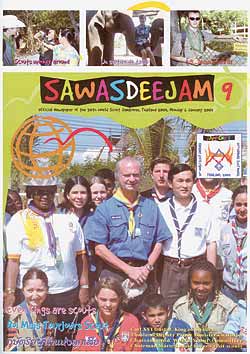
IST members are age 18 and older and work in support areas such as health care, human resources, logistics, administration, communications, and risk management (security). Because of my experience as a professional writer and photographer, I was offered a position on the staff of Sawasdeejam, the jamboree's daily eight-page newspaper. Articles were printed in French, English, or Thai. This required a large staff familiar with one or more of the three languages: eight editors, 22 writers and reporters, 21 photographers, two art directors, and three production coordinators. Richard Amalvy of the World Scout Bureau served as the newspaper's editor-in-chief as well as the jamboree's director of public relations. His message to the volunteer staff was simple but direct: Everything we published was about, or for the benefit of, the Scouts. All politics were to be put aside, and we adults were there to make the jamboree experience as fun and educational as possible for the young participants. Over two weeks, we processed more than 13,000 digital images and approximately 230 rolls of 35mm film. I spent most of my time reviewing digital images on CDs and helping choose photos for publication. Writers and photographers came and went all day, while the editors and production staff stayed into the night to review material and close out pages. The deadline for sending the paper to the printer was midnight. —K.B. |
May-June 2003 Table of Contents
Copyright © 2003 by the Boy Scouts of America. All rights thereunder reserved; anything appearing in Scouting magazine or on its Web site may not be reprinted either wholly or in part without written permission. Because of freedom given authors, opinions may not reflect official concurrence.
| The Boy Scouts of America | http://www.scouting.org |
